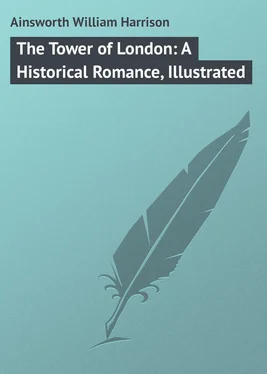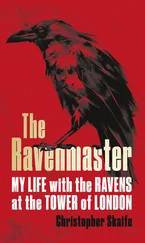William Ainsworth - The Tower of London - A Historical Romance, Illustrated
Здесь есть возможность читать онлайн «William Ainsworth - The Tower of London - A Historical Romance, Illustrated» — ознакомительный отрывок электронной книги совершенно бесплатно, а после прочтения отрывка купить полную версию. В некоторых случаях можно слушать аудио, скачать через торрент в формате fb2 и присутствует краткое содержание. ISBN: , Жанр: foreign_prose, на английском языке. Описание произведения, (предисловие) а так же отзывы посетителей доступны на портале библиотеки ЛибКат.
- Название:The Tower of London: A Historical Romance, Illustrated
- Автор:
- Жанр:
- Год:неизвестен
- ISBN:http://www.gutenberg.org/ebooks/49850
- Рейтинг книги:5 / 5. Голосов: 1
-
Избранное:Добавить в избранное
- Отзывы:
-
Ваша оценка:
- 100
- 1
- 2
- 3
- 4
- 5
The Tower of London: A Historical Romance, Illustrated: краткое содержание, описание и аннотация
Предлагаем к чтению аннотацию, описание, краткое содержание или предисловие (зависит от того, что написал сам автор книги «The Tower of London: A Historical Romance, Illustrated»). Если вы не нашли необходимую информацию о книге — напишите в комментариях, мы постараемся отыскать её.
The Tower of London: A Historical Romance, Illustrated — читать онлайн ознакомительный отрывок
Ниже представлен текст книги, разбитый по страницам. Система сохранения места последней прочитанной страницы, позволяет с удобством читать онлайн бесплатно книгу «The Tower of London: A Historical Romance, Illustrated», без необходимости каждый раз заново искать на чём Вы остановились. Поставьте закладку, и сможете в любой момент перейти на страницу, на которой закончили чтение.
Интервал:
Закладка:
William Harrison Ainsworth
The Tower of London: A Historical Romance, Illustrated
PREFACE
It has been, for years, the cherished wish of the writer of the following pages, to make the Tower of London – the proudest monument of antiquity, considered with reference to its historical associations, which this country or any other possesses, – the groundwork of a Romance; and it was no slight satisfaction to him, that circumstances, at length, enabled him to carry into effect his favourite project, in conjunction with the inimitable Artist, whose designs accompany the work.
Desirous of exhibiting the Tower in its triple light of a palace, a prison, and a fortress, the Author has shaped his story with reference to that end; and he has also endeavoured to contrive such a series of incidents as should naturally introduce every relic of the old pile, – its towers, chapels, halls, chambers, gateways, arches, and drawbridges – so that no part of it should remain un-illustrated.
How far this design has been accomplished – what interest has been given to particular buildings – and what mouldering walls have been informed with life – is now to be determined: – unless, indeed, it may be considered determined by the numbers who have visited the different buildings, as they have been successively depicted by pen and pencil, during the periodical appearance of the work.
One important object the Author would fain hope his labours may achieve. This is the introduction of the public to some parts of the fortress at present closed to them. There seems no reason why admission should not be given, under certain restrictions, to that unequalled specimen of Norman architecture, Saint John’s Chapel in the White Tower, – to the arched galleries above it, – to the noble council-chamber, teeming with historical recollections, – to the vaulted passages – and to the winding staircases within the turrets – so perfect, and so interesting to the antiquary. Nor is there stronger reason why the prison-chamber in the Beauchamp Tower, now used as a mess-room, the walls of which, like a mystic scroll, are covered with inscriptions – each a tragic story in itself, and furnishing matter for abundant reflection – should not likewise be thrown open. Most of the old fortifications upon the inner ballium-wall being converted into private dwellings, – though in many cases the chambers are extremely curious, and rich in inscriptions, – are, of course, inaccessible. But this does not apply to the first-mentioned places. They are the property of the nation, and should be open to national inspection.
It is piteous to see what havoc has already been made by alterations and repairs. The palace is gone – so are many of the towers – and unless the progress of destruction is arrested, the demolition of others will follow. Let us attempt to preserve what remains.
Opposite the matchless White Tower – William of Orange by the side of William the Conqueror, – is that frightful architectural abomination, the Grand Store-House.
It may not be possible to remove this ugly and incongruous structure. It is not possible to take away others that offend the eye at every turn. It is not possible to restore the Tower to its pristine grandeur. But it is possible to prevent further mutilation and desecration. It is possible to clear the reverend and massive columns of Saint John’s Chapel, which look like giants of departed days, from the thick coat of white-wash in which they are crusted, – to sweep away the presses with which its floors are cumbered, and to find some other equally secure, but less interesting – less sacred, in every sense, depository for the Chancery rolls. It is possible to render the same service to the magnificent council-chamber, and the passages leading to it, – it is possible to clear the walls of the Beauchamp Tower, – and it is , also, possible and desirable, that the public should be admitted to these places, in which they have so strong an interest. The visiter to the Tower sees little – and can see little of its most curious features. But it is the hope of the writer, that the day is not far off, when all that is really worth seeing will be accessible. In this view, the present publication may not be without use.
To those, who conceive that the Author has treated the character of Queen Mary with too great leniency, he can only affirm that he has written according to his conviction of the truth. Mary’s worst fault as a woman – her sole fault as a sovereign – was her bigotry: and it is time that the cloud, which prejudice has cast over her, should be dispersed. “Let us judge of her dispassionately and disinterestedly,” says Griffet 1 1 Nouveaux Eclaircissements sur l’Histoire de Marie, Reine d’Angleterre. Adressés à M. David Hume. 1760.
; “let us listen to the testimony of those who have known her, and have had the best means of examining her actions and her discourse. Let us do this, and we may perhaps discover that the reproaches which Protestant writers have heaped upon her have been excessive; and after a strict and impartial examination of her character, we may recognise in her qualities worthy of praise.” To this authority may be added that of Mr. Patrick Fraser Tytler, and Sir Frederick Madden, the latter of whom, in his able introduction to the “ Privy Purse Expenses of the Princess Mary ,” has most eloquently vindicated her.
Presuming upon the favour which the present work has experienced, the Author begs to intimate that he has other chronicles of the old fortress in contemplation, which he hopes to find leisure to produce. Those who desire further insight into its history and antiquities, are referred to Mr. Bayley’s excellent and comprehensive work on the subject, – a publication not so much known as it deserves to be, and from which much important information contained in the present volume has been derived.
It would be unpardonable in both Author and Illustrator, were they to omit to allude to the courtesy and attention they have experienced from the gentlemen connected with the different departments of the Tower, as well as from the occupants of the various fortifications. They beg, therefore, to offer their cordial acknowledgments to Major Elrington, fort-major and acting governor; to Edmund L. Swift, Esq., keeper of the regalia; to Robert Porrett, Esq., F. S. A., of the Principal Store-keeper’s Office; and George Stacey, Esq., of the same; to Thomas Hardy, Esq., F. S. A., keeper of the records in the Tower; to Lieutenant Hall, barrack-master; and to many others.
The Author’s best thanks are, also, due to Sir Henry Bedingfeld, Bart., of Oxburgh Hall, Norfolk, (the lineal descendant of the Lieutenant of the Tower introduced in the following pages,) for his obliging communications respecting his ancestor.
“And so,” to adopt the words of old Stow, in his continuation of Holinshed’s Chronicle, “craving a favourable acceptation of this tedious travail, with a toleration of all such faults, as haply therein lie hidden, and by diligent reading may soon be spied (especially by the critics), we wish that they which best may, would once in their life grow resolute and at a point in this laudable kind of study, most necessary for common knowledge, little or much to exercise their head and hand. Finally, beseeching God to bless these realms, and its ever precious jewel, our gracious Queen Victoria, and the infant princess newly given to us; to save them as the apple of his eye; and to protect them with the target of his power against all ill, – the Chronicler, in all humility, takes his leave.”
Kensal Lodge, Harrow Road, November 28, 1840.
BOOK ONE
Интервал:
Закладка:
Похожие книги на «The Tower of London: A Historical Romance, Illustrated»
Представляем Вашему вниманию похожие книги на «The Tower of London: A Historical Romance, Illustrated» списком для выбора. Мы отобрали схожую по названию и смыслу литературу в надежде предоставить читателям больше вариантов отыскать новые, интересные, ещё непрочитанные произведения.
Обсуждение, отзывы о книге «The Tower of London: A Historical Romance, Illustrated» и просто собственные мнения читателей. Оставьте ваши комментарии, напишите, что Вы думаете о произведении, его смысле или главных героях. Укажите что конкретно понравилось, а что нет, и почему Вы так считаете.












